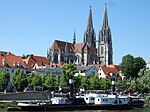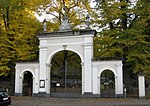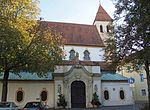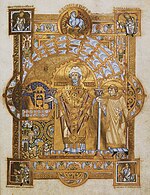Saint Emmeram's Abbey
8th-century churches in Germany8th-century establishments in GermanyBasilica churches in GermanyBavarian CircleBenedictine monasteries in Germany ... and 12 more
Burial sites of the Carolingian dynastyBurial sites of the House of Thurn und TaxisBurial sites of the LuitpoldingsCastles in BavariaChristian monasteries established in the 8th centuryChurches completed in 739Imperial abbeysImperial abbeys disestablished in 1802–03Monasteries in BavariaPalaces in BavariaRoman Catholic churches in RegensburgThurn und Taxis residences

Saint Emmeram's Abbey (German: Kloster Sankt Emmeram or Reichsabtei Sankt Emmeram) was a Benedictine monastery founded around 739 at Regensburg in Bavaria (modern-day southeastern Germany) at the grave of the itinerant Frankish bishop Saint Emmeram. The original abbey church is now a parish church named St. Emmeram's Basilica. The other buildings on the site form a large complex known as Schloss Thurn und Taxis or Schloss St. Emmeram, which has served as the main residence of the Thurn und Taxis princely family since the early 19th century.
Excerpt from the Wikipedia article Saint Emmeram's Abbey (License: CC BY-SA 3.0, Authors, Images).Saint Emmeram's Abbey
Emmeramsplatz, Regensburg Altstadt
Geographical coordinates (GPS) Address Nearby Places Show on map
Geographical coordinates (GPS)
| Latitude | Longitude |
|---|---|
| N 49.015277777778 ° | E 12.092777777778 ° |
Address
Basilika St. Emmeram
Emmeramsplatz 4
93047 Regensburg, Altstadt
Bavaria, Germany
Open on Google Maps











